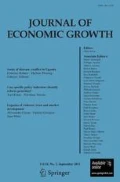Abstract
This paper studies the pattern of allocation of foreign aid from various donors to receiving countries. We find considerable evidence that the direction of foreign aid is dictated as much by political and strategic considerations, as by the economic needs and policy performance of the recipients. Colonial past and political alliances are major determinants of foreign aid. At the margin, however, countries that democratize receive more aid, ceteris paribus. While foreign aid flows respond to political variables, foreign direct investments are more sensitive to economic incentives, particularly “good policies” and protection of property rights in the receiving countries. We also uncover significant differences in the behavior of different donors.
Similar content being viewed by others
References
Ball, R., and C. Jonson. (1996). “Political, Economic and Humanitarian Motivations for PL 480 Food Aid: Evidence from Africa,” Economic Development and Cultural Change 44 (April), 515-547.
Barro, R. (1996). “Democracy and Growth,” Journal of Economic Growth 1, 1-27.
Boone, P. (1994). “The Impact of Foreign Aid on Savings and Growth.” Mimeo, London School of Economics.
Boone, P. (1996). “Politics and the Effectiveness of Foreign Aid,” European Economic Review 40, 289-329.
Burnside, C., and D. Dollar. (forthcoming). “Aid, Policies, and Growth,” American Economic Review.
Central Intelligence Agency. (1996). The World Factbook. Brassey's.
Collier, P., and D. Dollar. (1998). “Aid Allocation and Poverty Reduction.” Policy ResearchWorking Paper 2041. The World Bank. Washington, DC.
Frey, B., and F. Schneider. (1986). “Competing Models of International Lending Activities,” Journal of Development Economics, 225-245.
Gastil, R. D. (1990). “The Comparison Survey of Freedom,” Studies in Comparative International Development 25(1), 25-50.
Gastil, R. D. Freedom in the World: Political Rights and Civil Liberties, 1986–87. Greenwood Press.
Greene, W. (1993). Econometric Analysis. Prentice Hall.
Inter-University Consortium for Political and Social Research. (1982). U.N. Roll Call Data, 1946-1985 [computer file]. Ann Arbor, MI.
Jepma, C. (1997). “On the Effectiveness of Development Aid.” World Bank, unpublished.
Ludborg, P. (1998). “Foreign Aid and International Support as a Gift Exchange.” Economics and Politics 10(July), 127-141.
Lumsdaine, D. H. (1997). Moral Vision in International Politics. Princeton, NJ: Princeton University Press.
McKinley, R. D., and R. Little. (1978). “The French Aid Relationship,” Development and Change, 459-478.
McKinley, R. D., and R. Little. (1979). “The U.S. Aid Relationship: A Test of the Recipient Need and Donor Interest Models,” Political Studies 27(2), 236-250.
Maizels, A., and M. Nissanke. (1984). “Motivations for Aid to Developing Countries,” World Development, 879-900.
OECD. (1996). Geographical Distribution of Financial Flows to Aid Recipients: 1960–95 (CD-Rom): OECD.
Political Risk Services. (Various years). International Country Risk Guide.
Sachs, J. D., and A. Warner. (1995). “Economic Reform and the Process of Global Integration,” Brookings Papers on Economic Activity 1, 1-118.
Schraeder, P., S. Hook, and B. Taylor. (1998). “Clarifying the Foreign Aid Puzzle: A Comparison of American, Japanese, French and Swedish Aid Flows,” World Politics, 294-320.
Summers, R., and A. Heston. (1988). “A New Set of International Comparisons of Real Products and Price Level Estimates for 130 Countries, 1950–1985,” Review of Income and Wealth 34, 1-25 (updated to 1992).
Trumbull, W., and H. Wall. (1994). “Estimating Aid-Allocation Criteria with Panel Data,” The Economic Journal, 876-892.
World Bank. (Various years). World Debt Tables. Baltimore, MD: Johns Hopkins University Press.
World Bank. (1998). Assessing Aid. New York: Oxford University Press.
Author information
Authors and Affiliations
Rights and permissions
About this article
Cite this article
Alesina, A., Dollar, D. Who Gives Foreign Aid to Whom and Why?. Journal of Economic Growth 5, 33–63 (2000). https://doi.org/10.1023/A:1009874203400
Issue Date:
DOI: https://doi.org/10.1023/A:1009874203400




